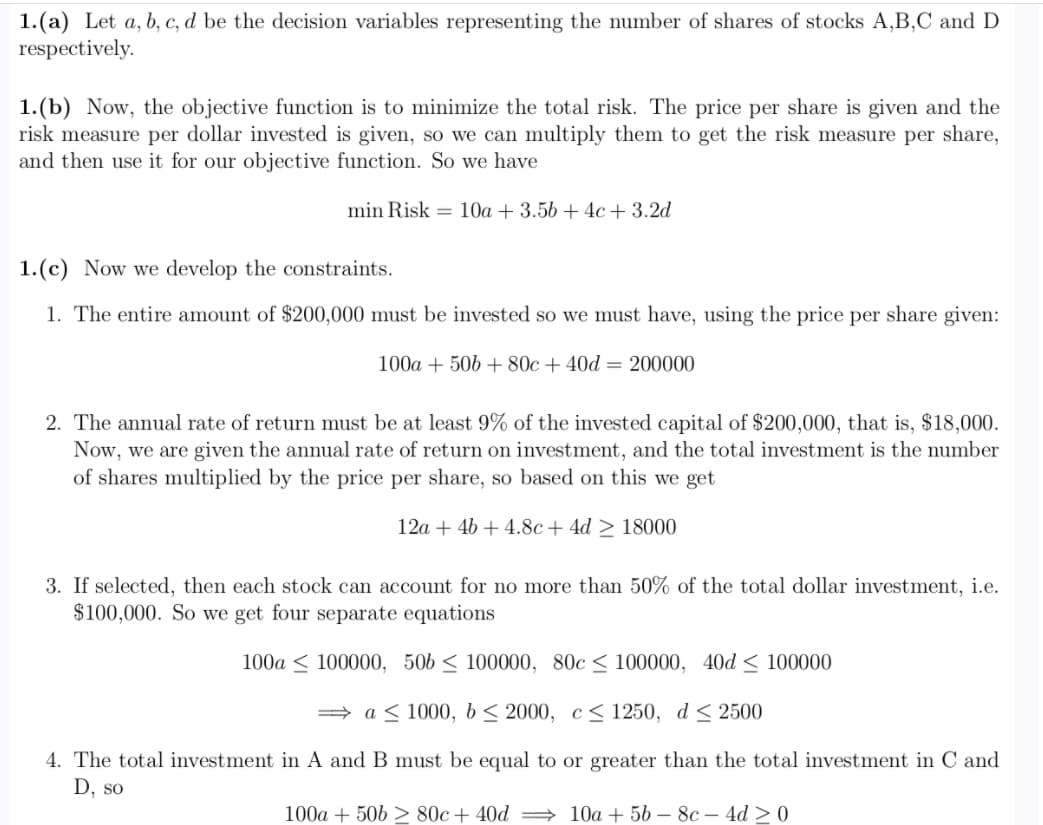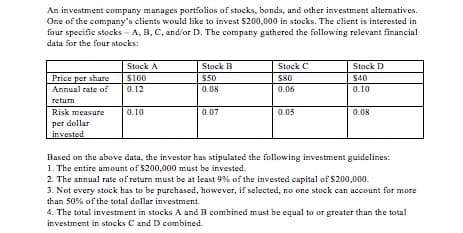An investment company manages portfolios of stocks, bonds, and other investment alternatives. One of the company's clients would like to invest $200,000 in stocks. The client is interested in four specific stocks - A, B, C, and'or D. The company gathered the following relevant financial data for the four stocks: Stock A $100 0.12 Stock B Stock C Stock D Price per share Annual rate of 550 0.08 S80 $40 0.06 0.10 retum Risk measure per dollar invested 0.10 0.07 0.05 0.08 Based on the above data, the investor has stipulated the following investment guidelines: 1. The entire amount of $200,000 must be invested. 2. The annual rate of return must be at least 9% of the invested capital of $200,000. 3. Not every stock has to be purchased, however, if selected, no one stock can account for more than 50% of the total dollar investment. 4. The total investment in stocks A and B combined must be equal to or greater than the total inYetment in teski Cand R sembined
An investment company manages portfolios of stocks, bonds, and other investment alternatives. One of the company's clients would like to invest $200,000 in stocks. The client is interested in four specific stocks - A, B, C, and'or D. The company gathered the following relevant financial data for the four stocks: Stock A $100 0.12 Stock B Stock C Stock D Price per share Annual rate of 550 0.08 S80 $40 0.06 0.10 retum Risk measure per dollar invested 0.10 0.07 0.05 0.08 Based on the above data, the investor has stipulated the following investment guidelines: 1. The entire amount of $200,000 must be invested. 2. The annual rate of return must be at least 9% of the invested capital of $200,000. 3. Not every stock has to be purchased, however, if selected, no one stock can account for more than 50% of the total dollar investment. 4. The total investment in stocks A and B combined must be equal to or greater than the total inYetment in teski Cand R sembined
Practical Management Science
6th Edition
ISBN:9781337406659
Author:WINSTON, Wayne L.
Publisher:WINSTON, Wayne L.
Chapter7: Nonlinear Optimization Models
Section7.7: Portfolio Optimization Models
Problem 38P: The stocks in Example 7.9 are all positively correlated. What happens when they are negatively...
Related questions
Question
2) What are the objective coefficient ranges for the four stocks? Show the relevant portion of the Solver’s output. Fully interpret these ranges.

Transcribed Image Text:1.(a) Let a, b, c, d be the decision variables representing the number of shares of stocks A,B,C and D
respectively.
1.(b) Now, the objective function is to minimize the total risk. The price per share is given and the
risk measure per dollar invested is given, so we can multiply them to get the risk measure per share,
and then use it for our objective function. So we have
min Risk = 10a + 3.56 + 4c+ 3.2d
1.(c) Now we develop the constraints.
1. The entire amount of $200,000 must be invested so we must have, using the price per share given:
100a + 506 + 80c + 40d = 200000
2. The annual rate of return must be at least 9% of the invested capital of $200,000, that is, $18,000.
Now, we are given the annual rate of return on investment, and the total investment is the number
of shares multiplied by the price per share, so based on this we get
12a + 4b + 4.8c+ 4d > 18000
3. If selected, then each stock can account for no more than 50% of the total dollar investment, i.e.
$100,000. So we get four separate equations
100a < 100000, 506 < 100000, 80c < 100000, 40d < 100000
= a < 1000, b< 2000, c< 1250, d < 2500
4. The total investment in A and B must be equal to or greater than the total investment in C and
D, so
100a + 506 > 80c+ 40d → 10a + 56 – 8c – 4d > 0

Transcribed Image Text:An investment company manages portfolios of stocks, bonds, and other investment alternatives.
One of the company's clients would like to invest $200,000 in stocks. The client is interested in
four specific stocks - A, B, C, and/or D. The company gathered the following relevant financial
data for the four stocks:
Stock C
Stock A
Stock B
Stock D
Price per share
S100
$50
S80
$40
Annual rate of
0.12
0.08
0.06
0.10
return
Risk measure
0.10
0.07
0.05
0.08
per dollar
invested
Based on the above data, the investor has stipulated the following investment guidelines:
1. The entire amount of $200,000 must be invested.
2. The annual rate of return must be at least 9% of the invested capital of $200,000.
3. Not every stock has to be purchased, however, if selected, no one stock can account for more
than 50% of the total dollar investment.
4. The total investment in stocks A and B combined must be equal to or greater than the total
investment in stocks C and D combined.
Expert Solution
This question has been solved!
Explore an expertly crafted, step-by-step solution for a thorough understanding of key concepts.
This is a popular solution!
Trending now
This is a popular solution!
Step by step
Solved in 2 steps with 3 images

Knowledge Booster
Learn more about
Need a deep-dive on the concept behind this application? Look no further. Learn more about this topic, operations-management and related others by exploring similar questions and additional content below.Recommended textbooks for you

Practical Management Science
Operations Management
ISBN:
9781337406659
Author:
WINSTON, Wayne L.
Publisher:
Cengage,

Practical Management Science
Operations Management
ISBN:
9781337406659
Author:
WINSTON, Wayne L.
Publisher:
Cengage,